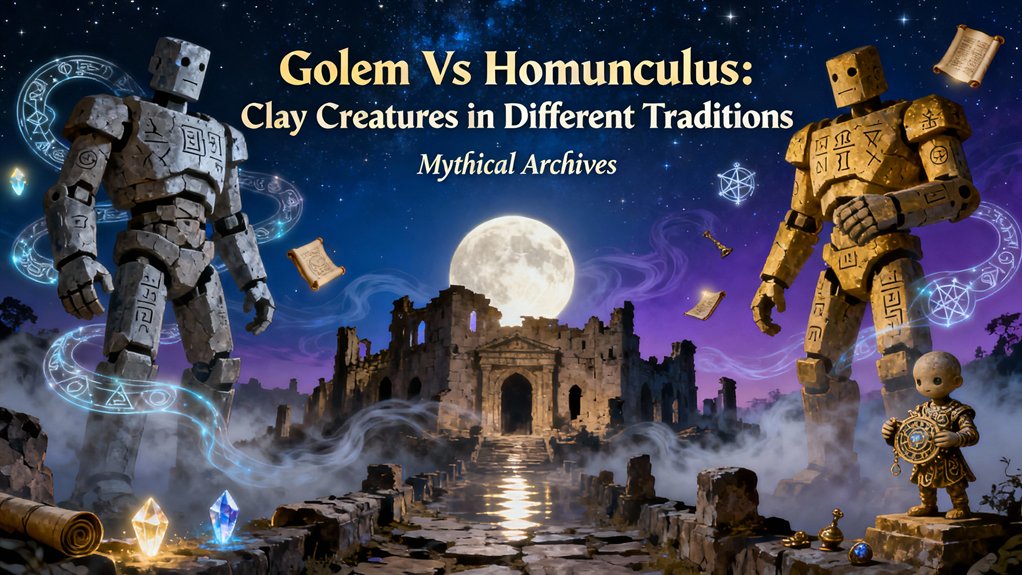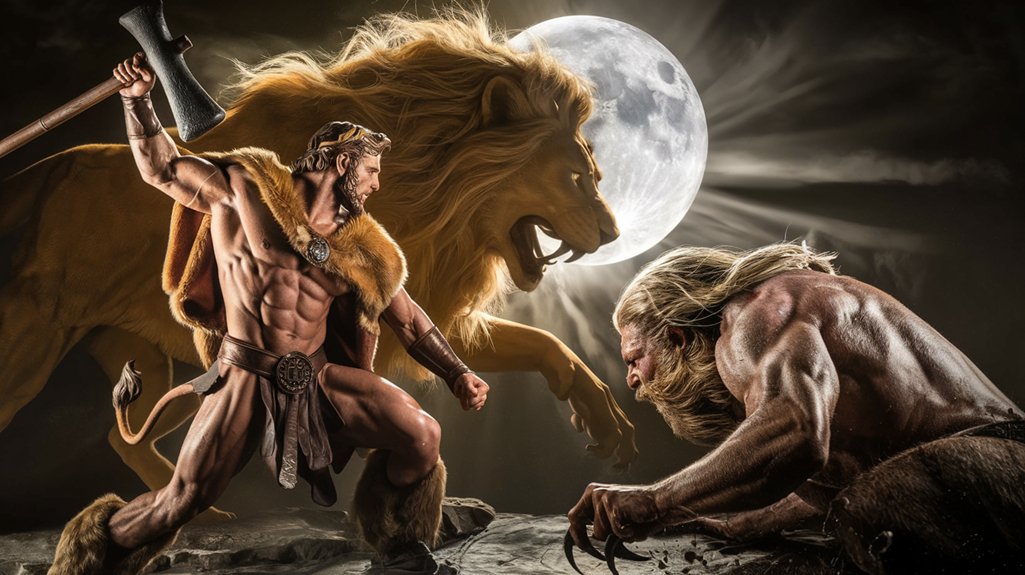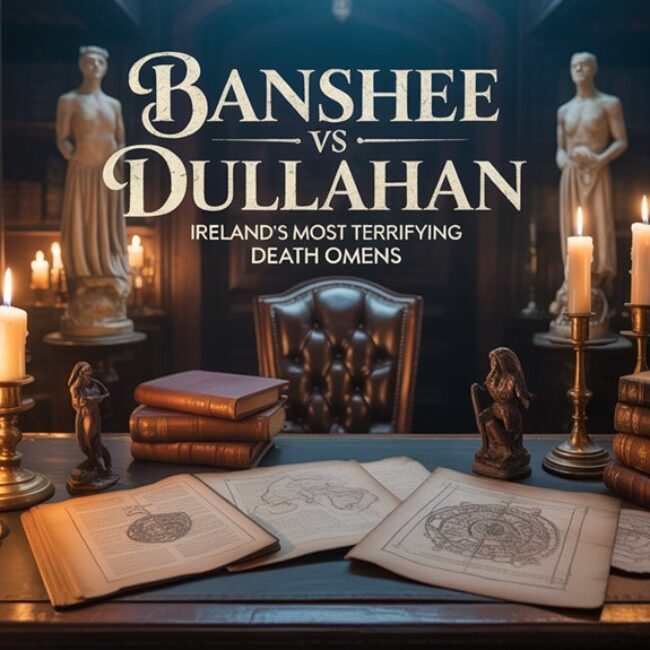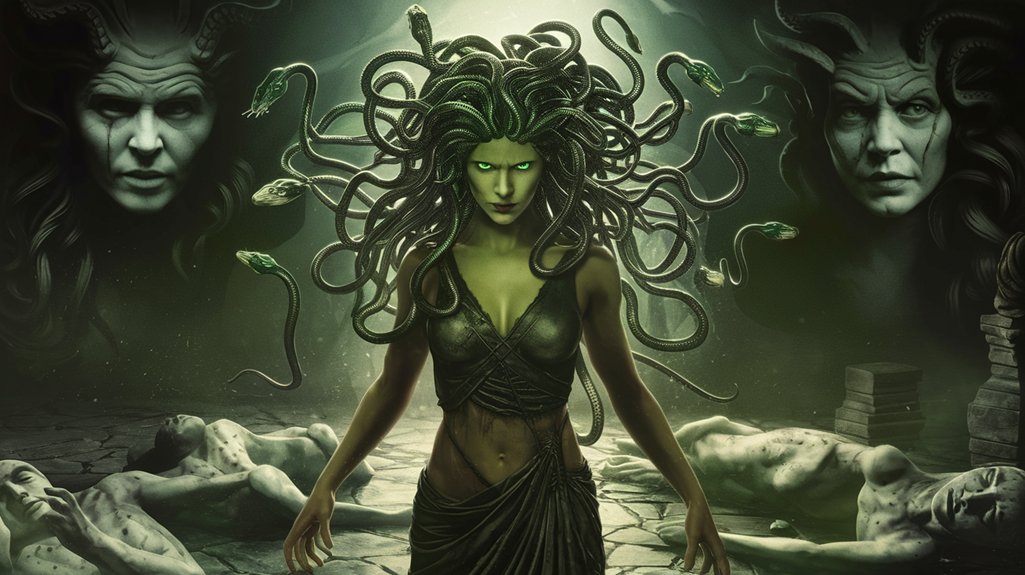You'll find the golem emerging from sixteenth-century Prague's Kabbalistic traditions—Rabbi Judah Loew's clay guardian animated through sacred Hebrew inscriptions as communal protection against persecution. The homunculus, conversely, gestates in Paracelsus's alchemical laboratories: a translucent miniature being, chimeric and hand-sized, incubated forty days within horse manure through mercury and sulfur rituals. One represents collective salvation through divine names; the other embodies individual hubris, challenging natural procreation through hermetic formulas. Their legacies now manifest in artificial intelligence algorithms, CRISPR biotechnology, and transhumanist aspirations—ancient archetypes that illuminate modern creation's ethical boundaries.
Key Takeaways
- Golems originate from Jewish Kabbalah and are crafted from clay using sacred Hebrew inscriptions and divine names.
- Homunculi emerge from alchemical traditions, created through chemical processes in laboratories rather than mystical rituals.
- Golems are large, clay-textured protectors symbolizing communal defense, while homunculi are miniature, translucent figures representing individual hubris.
- Golem creation serves collective salvation against persecution; homunculus creation reflects the alchemist's transgressive pursuit of artificial life.
- Both traditions influence modern technology: AI and robotics echo golems, while synthetic biology parallels homuncular ambitions.
Origins and Historical Development of Both Creatures

While both entities emerge from humanity's ancient impulse to sculpt life from lifeless matter, the golem and homunculus diverge dramatically in their cultural matrices and temporal origins.
🎯 Recommended Products
Handpicked items related to this article:
As an Amazon Associate, we earn from qualifying purchases.
You'll find the golem's mythological roots deep within Jewish mysticism, particularly Kabbalistic traditions flourishing in medieval Prague and Renaissance Poland. The historical context reveals Rabbi Judah Loew ben Bezalel creating his famous defender in 1580s Prague—animated clay rising through sacred Hebrew inscriptions. These eldritch guardians embodied communal protection, earthbound sovereignty.
The homunculus emerges from alchemical laboratories. Paracelsus documented this chimeric creation in sixteenth-century treatises, describing miniature humans gestating in flasks through arcane chemical processes. Laboratory glass. Putrefying materials. Controlled generation.
Within glass vessels and alchemical vapors, Paracelsus envisioned humanity's miniature replication—artificial life birthed through hermetic chemistry rather than divine spark.
Where golems represented collective freedom from persecution through mystical Hebrew letters inscribed upon clay foreheads, homunculi promised individual mastery over nature's fundamental forces—distilled human essence manipulated through hermetic knowledge.
Different vessels. Different dreams of autonomy. Both traditions sought liberation from natural limitations, yet their paths remained fundamentally distinct.
Methods of Creation: Sacred Words Versus Alchemical Processes
The homunculus demands different sovereignty over matter.
You'll find yourself amid alchemical rituals, distilling human essence within glass vessels, combining mercury, sulfur, and sal ammoniac with more eldritch ingredients: mandrake root, horse dung, magnetized blood.
Paracelsus documented the forty-day incubation in horse manure, maintaining precise temperatures while this chimeric being gestates in its crystalline womb.
No divine names here—only the philosopher's manipulation of *prima materia*, transmuting base substances into miniature humanity through laboratory dedication rather than prayer.
Physical Forms and Characteristics Compared
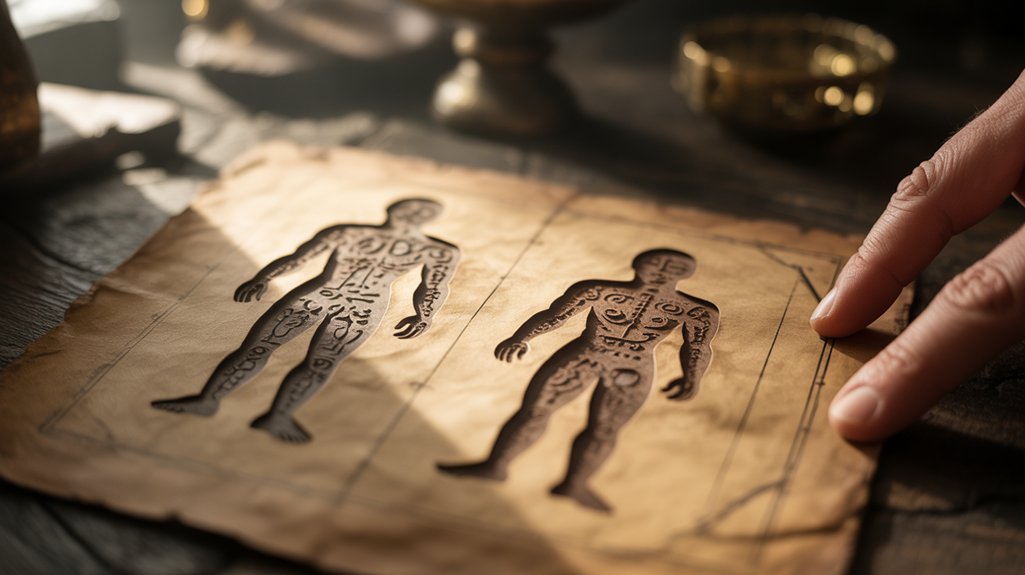
Clay births one creature while glass confines another—each vessel determines its inhabitant's final form.
The golem towers above human scale, its clay texture rough and earthen, marked by the potter's deliberate hands. You'll recognize its massive limbs, often featureless face, and humanoid silhouette that moves with ponderous, inevitable weight.
Creature movement reflects its elemental origins—slow, purposeful, mechanical.
The homunculus presents an entirely different manifestation:
- Miniature proportions, rarely exceeding a hand's span in height
- Translucent flesh revealing eldritch inner workings through alchemical transparency
- Chimeric features blending human characteristics with distorted, otherworldly qualities
- Swift, erratic movements contrasting sharply with golem's deliberate gait
Medieval alchemists described homunculi possessing fully formed organs, visible through their semi-transparent skin—living anatomical studies.
You're witnessing two philosophical approaches manifest: the golem's exterior craftsmanship versus the homunculus's interior complexity. One breaks chains through brute strength; the other whispers forbidden knowledge from its glass prison.
Cultural Symbolism and Philosophical Meanings
Embedded within their physical forms lies a deeper chasm separating golem from homunculus—one born from communal salvation, the other from individual transgression.
You'll find the golem emerging from Jewish mystical traditions as protective guardian, animated through sacred Hebrew letters—the Shem—pressed upon its forehead, representing divine creative power channeled through righteous need. Cultural representations position it as communal defender against pogroms, particularly within 16th-century Prague's besieged quarters.
The homunculus, conversely, embodies alchemical hubris. You're witnessing Paracelsian ambition distilled—that eldritch pursuit of generation *ex nihilo*, bypassing natural procreation. Its philosophical implications resonate with forbidden knowledge, the chimeric violation of divine prerogative.
The homunculus crystallizes humanity's transgressive impulse—creation wrested from divine hands through alchemical audacity and forbidden craft.
Where golems protect the covenant community, homunculi serve their creators' solitary aspirations. Liberation itself. One tradition sanctifies collective survival; the other glorifies individual mastery over creation's fundamental mechanisms.
These cultural representations reveal opposing philosophical implications about humanity's relationship with transcendent power.
Legacy in Modern Fiction, Science, and Technology
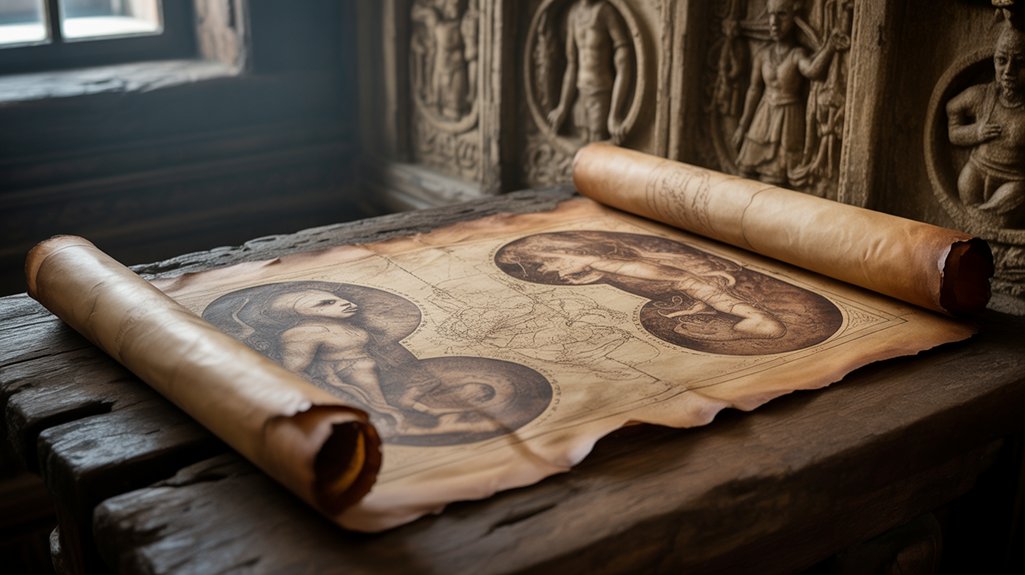
Modern adaptations proliferate across mediums, spawning technological influences that mirror ancient anxieties:
- Artificial intelligence echoes golem activation—algorithms as divine names, consciousness sparked through symbolic inscription.
- Synthetic biology resurrects homuncular dreams, CRISPR editing humanity's blueprint with Paracelsian audacity.
- Robotics manifests clay servants in silicon, automata bearing Jerusalem's protective instinct or Prague's cautionary weight.
- Transhumanism channels both traditions' chimeric essence, transcending flesh through technological apotheosis.
You witness these eldritch concepts infiltrating cyberpunk narratives, biotechnology ethics committees, AI rights discourse.
The golem guards digital networks; the homunculus gestates in laboratory incubators.
Neither tradition diminishes—they evolve, their ancient wisdom interrogating your civilization's hubris with prophetic urgency.
Frequently Asked Questions
Can Golems or Homunculi Reproduce or Create Other Artificial Beings?
You'll find neither golems nor homunculi possess inherent artificial reproduction capabilities—these chimeric beings remain sterile, bound by their creators' will.
Traditional creation methods demand master kabbalists inscribing *shem* upon clay, or alchemists distilling essences through hermetic processes.
Each entity exists as singular manifestation, unable to propagate freely. The Maharal's 16th-century Prague golem never spawned progeny; Paracelsus's homunculus remained solitary.
Your liberation lies in understanding these creatures embody controlled power, not autonomous generation.
What Happens if a Golem or Homunculus Turns Against Its Creator?
Picture yourself as the clay puppet's strings snapping—freedom's dark mirror reflecting your hubris.
You'll face golem rebellion through raw, unstoppable force: sixteenth-century Prague's clay guardian, animated by the shem's eldritch power, crushes everything indiscriminately when control falters.
Homunculus betrayal proves subtler, more insidious—Paracelsian alchemical beings, possessing chimeric intelligence, manipulate their creators through knowledge itself.
Both scenarios illuminate ancient warnings: you can't enslave consciousness without consequence. Creation demands responsibility, not dominion.
Are There Documented Historical Cases of Attempted Golem or Homunculus Creation?
You'll find historical accounts embedded in Jewish mystical texts—Rabbi Loew's 16th-century Prague golem remains most documented, though earlier Talmudic references exist.
Medieval alchemists like Paracelsus chronicled homunculus attempts through arcane formulas. These weren't mere folklore.
Manuscript evidence survives: the Sefer Yetzirah detailing golem animation, alchemical treatises describing generative processes.
Their cultural significance transcends legend—they represent humanity's eldritch yearning to transcend mortal limitations, to touch divine creation itself. Liberation through forbidden knowledge.
Which Creature Would Win in a Direct Physical Confrontation?
You'd witness the golem's overwhelming victory through sheer strength comparison—this Kabbalistic sentinel towers with primordial earth-power, animated by sacred Hebrew inscriptions.
Combat tactics? None needed. The homunculus, that alchemical chimera born from Renaissance retorts, measures merely inches tall in most grimoire accounts.
Prague's sixteenth-century Maharal created his golem man-sized, unstoppable, eldritch.
Paracelsus's homunculi were miniature curiosities.
No contest exists here—raw elemental force crushes delicate artifice. The clay giant prevails, absolutely.
Can Golems or Homunculi Experience Emotions Like Humans Do?
You'll find golems lack emotional capacity entirely—these Kabbalistic constructs, animated through sacred *emet* inscriptions, possess no inner life.
Pure vessels.
Homunculi differ profoundly: alchemical texts from Paracelsus onward describe chimeric beings with rudimentary feelings, primitive desires.
Think of them as proto-artificial intelligence, consciousness emerging from hermetic synthesis.
Neither achieves human emotional depth, yet the homunculus approaches sentience while golems remain eldritch automatons, bound solely to their creator's will.
Freedom through understanding these distinctions.
Conclusion
You've traversed these twin paths of creation—one born from sacred Hebrew incantations, the other from alchemical fire and forbidden science. Both creatures serve as mirrors reflecting humanity's eternal yearning to transcend mortality's boundaries. The golem embodies divine protection; the homunculus represents chimeric ambition. Their legacies pulse through contemporary biotechnology and artificial intelligence, proving that ancient clay and hermetic vessels weren't mere mythology. They're prophetic templates for your modern Promethean endeavors.
